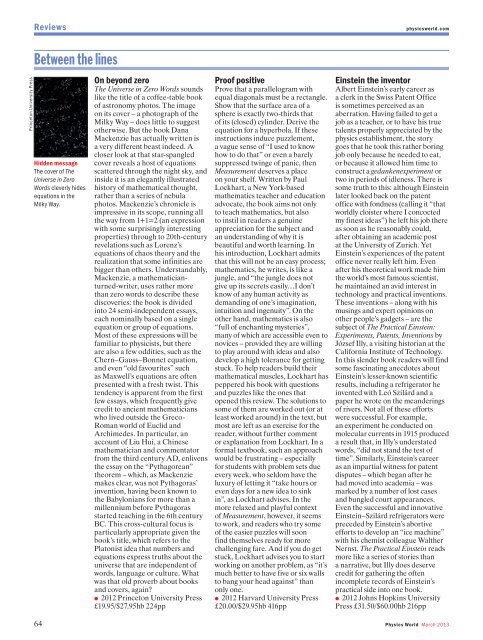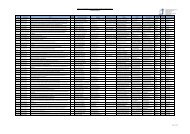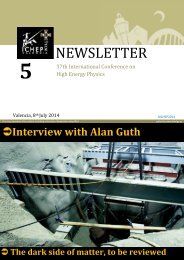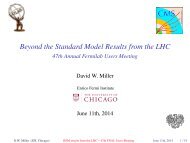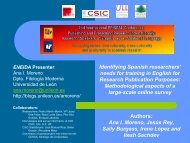PW_mar13_sample_issue
PW_mar13_sample_issue
PW_mar13_sample_issue
You also want an ePaper? Increase the reach of your titles
YUMPU automatically turns print PDFs into web optimized ePapers that Google loves.
Princeton University Press<br />
Reviews<br />
Between the lines<br />
Hidden message<br />
The cover of The<br />
Universe in Zero<br />
Words cleverly hides<br />
equations in the<br />
Milky Way.<br />
64<br />
On beyond zero<br />
The Universe in Zero Words sounds<br />
like the title of a coffee-table book<br />
of astronomy photos. The image<br />
on its cover – a photograph of the<br />
Milky Way – does little to suggest<br />
otherwise. But the book Dana<br />
Mackenzie has actually written is<br />
a very different beast indeed. A<br />
closer look at that star-spangled<br />
cover reveals a host of equations<br />
scattered through the night sky, and<br />
inside it is an elegantly illustrated<br />
history of mathematical thought,<br />
rather than a series of nebula<br />
photos. Mackenzie’s chronicle is<br />
impressive in its scope, running all<br />
the way from 1+1=2 (an expression<br />
with some surprisingly interesting<br />
properties) through to 20th-century<br />
revelations such as Lorenz’s<br />
equations of chaos theory and the<br />
realization that some infinities are<br />
bigger than others. Understandably,<br />
Mackenzie, a mathematicianturned-writer,<br />
uses rather more<br />
than zero words to describe these<br />
discoveries: the book is divided<br />
into 24 semi-independent essays,<br />
each nominally based on a single<br />
equation or group of equations.<br />
Most of these expressions will be<br />
familiar to physicists, but there<br />
are also a few oddities, such as the<br />
Chern–Gauss–Bonnet equation,<br />
and even “old favourites” such<br />
as Maxwell’s equations are often<br />
presented with a fresh twist. This<br />
tendency is apparent from the first<br />
few essays, which frequently give<br />
credit to ancient mathematicians<br />
who lived outside the Greco-<br />
Roman world of Euclid and<br />
Archimedes. In particular, an<br />
account of Liu Hui, a Chinese<br />
mathematician and commentator<br />
from the third century AD, enlivens<br />
the essay on the “Pythagorean”<br />
theorem – which, as Mackenzie<br />
makes clear, was not Pythagoras’<br />
invention, having been known to<br />
the Babylonians for more than a<br />
millennium before Pythagoras<br />
started teaching in the 6th century<br />
BC. This cross-cultural focus is<br />
particularly appropriate given the<br />
book’s title, which refers to the<br />
Platonist idea that numbers and<br />
equations express truths about the<br />
universe that are independent of<br />
words, language or culture. What<br />
was that old proverb about books<br />
and covers, again?<br />
● 2012 Princeton University Press<br />
£19.95/$27.95hb 224pp<br />
Proof positive<br />
Prove that a parallelogram with<br />
equal diagonals must be a rectangle.<br />
Show that the surface area of a<br />
sphere is exactly two-thirds that<br />
of its (closed) cylinder. Derive the<br />
equation for a hyperbola. If these<br />
instructions induce puzzlement,<br />
a vague sense of “I used to know<br />
how to do that” or even a barely<br />
suppressed twinge of panic, then<br />
Measurement deserves a place<br />
on your shelf. Written by Paul<br />
Lockhart, a New York-based<br />
mathematics teacher and education<br />
advocate, the book aims not only<br />
to teach mathematics, but also<br />
to instil in readers a genuine<br />
appreciation for the subject and<br />
an understanding of why it is<br />
beautiful and worth learning. In<br />
his introduction, Lockhart admits<br />
that this will not be an easy process;<br />
mathematics, he writes, is like a<br />
jungle, and “the jungle does not<br />
give up its secrets easily…I don’t<br />
know of any human activity as<br />
demanding of one’s imagination,<br />
intuition and ingenuity”. On the<br />
other hand, mathematics is also<br />
“full of enchanting mysteries”,<br />
many of which are accessible even to<br />
novices – provided they are willing<br />
to play around with ideas and also<br />
develop a high tolerance for getting<br />
stuck. To help readers build their<br />
mathematical muscles, Lockhart has<br />
peppered his book with questions<br />
and puzzles like the ones that<br />
opened this review. The solutions to<br />
some of them are worked out (or at<br />
least worked around) in the text, but<br />
most are left as an exercise for the<br />
reader, without further comment<br />
or explanation from Lockhart. In a<br />
formal textbook, such an approach<br />
would be frustrating – especially<br />
for students with problem sets due<br />
every week, who seldom have the<br />
luxury of letting it “take hours or<br />
even days for a new idea to sink<br />
in”, as Lockhart advises. In the<br />
more relaxed and playful context<br />
of Measurement, however, it seems<br />
to work, and readers who try some<br />
of the easier puzzles will soon<br />
find themselves ready for more<br />
challenging fare. And if you do get<br />
stuck, Lockhart advises you to start<br />
working on another problem, as “it’s<br />
much better to have five or six walls<br />
to bang your head against” than<br />
only one.<br />
● 2012 Harvard University Press<br />
£20.00/$29.95hb 416pp<br />
physicsworld.com<br />
Einstein the inventor<br />
Albert Einstein’s early career as<br />
a clerk in the Swiss Patent Office<br />
is sometimes perceived as an<br />
aberration. Having failed to get a<br />
job as a teacher, or to have his true<br />
talents properly appreciated by the<br />
physics establishment, the story<br />
goes that he took this rather boring<br />
job only because he needed to eat,<br />
or because it allowed him time to<br />
construct a gedankenexperiment or<br />
two in periods of idleness. There is<br />
some truth to this: although Einstein<br />
later looked back on the patent<br />
office with fondness (calling it “that<br />
worldly cloister where I concocted<br />
my finest ideas”) he left his job there<br />
as soon as he reasonably could,<br />
after obtaining an academic post<br />
at the University of Zurich. Yet<br />
Einstein’s experiences of the patent<br />
office never really left him. Even<br />
after his theoretical work made him<br />
the world’s most famous scientist,<br />
he maintained an avid interest in<br />
technology and practical inventions.<br />
These inventions – along with his<br />
musings and expert opinions on<br />
other people’s gadgets – are the<br />
subject of The Practical Einstein:<br />
Experiments, Patents, Inventions by<br />
József Illy, a visiting historian at the<br />
California Institute of Technology.<br />
In this slender book readers will find<br />
some fascinating anecdotes about<br />
Einstein’s lesser-known scientific<br />
results, including a refrigerator he<br />
invented with Leó Szilárd and a<br />
paper he wrote on the meanderings<br />
of rivers. Not all of these efforts<br />
were successful. For example,<br />
an experiment he conducted on<br />
molecular currents in 1915 produced<br />
a result that, in Illy’s understated<br />
words, “did not stand the test of<br />
time”. Similarly, Einstein’s career<br />
as an impartial witness for patent<br />
disputes – which began after he<br />
had moved into academia – was<br />
marked by a number of lost cases<br />
and bungled court appearances.<br />
Even the successful and innovative<br />
Einstein–Szilárd refrigerators were<br />
preceded by Einstein’s abortive<br />
efforts to develop an “ice machine”<br />
with his chemist colleague Walther<br />
Nernst. The Practical Einstein reads<br />
more like a series of stories than<br />
a narrative, but Illy does deserve<br />
credit for gathering the often<br />
incomplete records of Einstein’s<br />
practical side into one book.<br />
● 2012 Johns Hopkins University<br />
Press £31.50/$60.00hb 216pp<br />
Physics World March 2013


